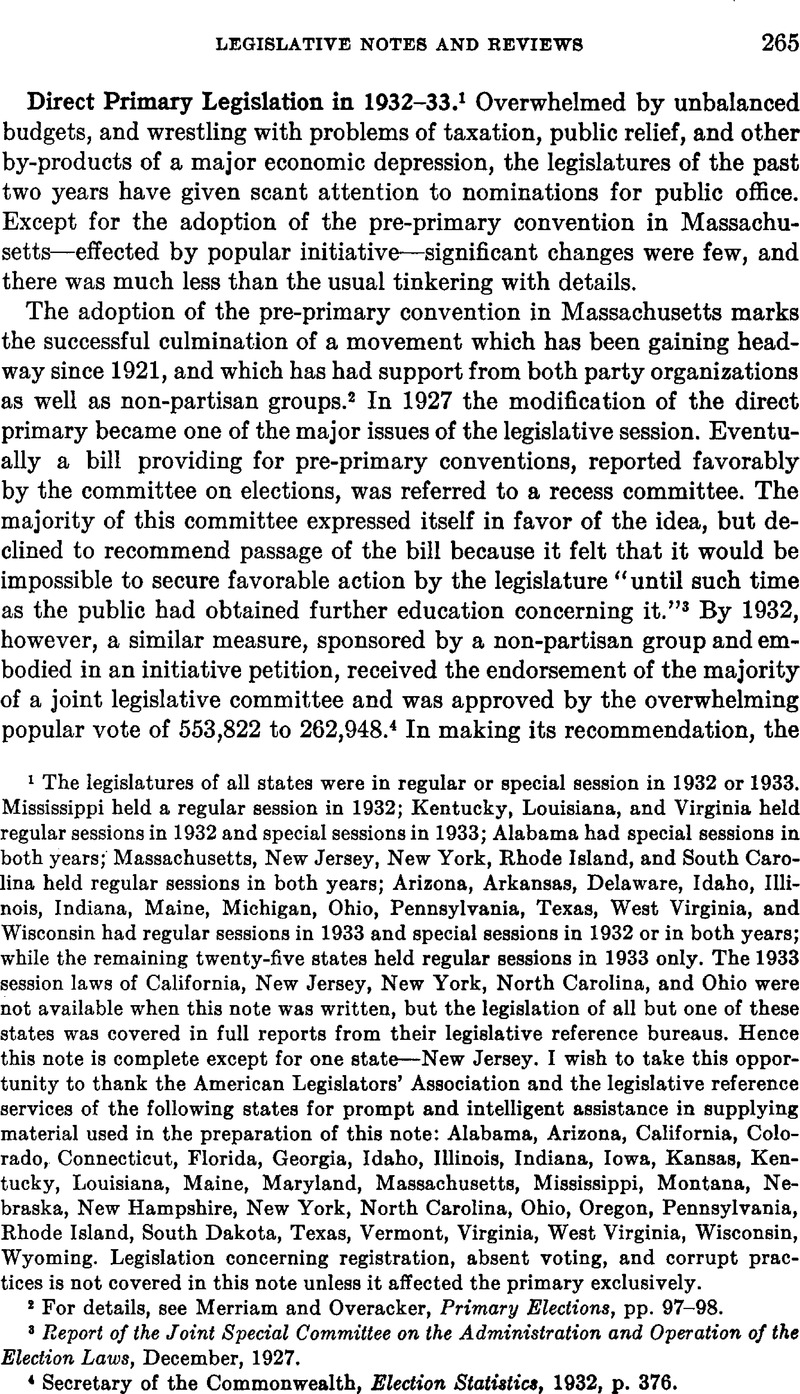Article contents
Direct Primary Legislation in 1932–331
Published online by Cambridge University Press: 02 September 2013
Abstract

- Type
- Legislative Notes and Reviews
- Information
- Copyright
- Copyright © American Political Science Association 1934
References
2 For details, see Merriam and Overacker, Primary Elections, pp. 97–98.
3 Report of the Joint Special Committee on the Administration and Operation of the Election Laws, December, 1927.
4 Secretary of the Commonwealth, Election Statistics, 1932, p. 376Google Scholar.
5 Official Information to Voters, State Election, November 8, 1932, p. 30Google Scholar.
6 The proposition was voted upon November 8, 1932, in an election in which interest was centered upon presidential and state contests. The 792,778 voters who left their ballots blank on the pre-primary proposition give eloquent testimony to the lack of interest. In the joint committee on election laws, nine Republicans and one Democrat supported the proposal, while five members—all Democrats—opposed it.
7 Acts and Resolves of Massachusetts, 1932, ch. 310 (to be published in the Acts and Resolves of Massachusetts, 1933, p. 3.Google Scholar)
8 Secs. 7, 12, 21, 22.
9 Sec. 5.
10 Sec. 9.
11 Sec. 7.
12 Sec. 21.
13 Secs. 3, 21, 22.
14 The Colorado law provides that any candidate receiving ten per cent or more of the votes in the convention shall have his name placed on the primary ballot. In South Dakota, the majority and minority factions in the convention were entitled to have their lists of candidates printed upon the primary ballot. In both states additional names could be filed by petition. The South Dakota law was repealed in 1929 (ch. 118).
15 Mr. Hughes first made his proposal in 1910, when he was governor of New York. A restatement and fuller consideration is to be found in “The Fate of the Direct Primary”, in National Municipal Review, vol. 10 (Jan., 1921), p. 23CrossRefGoogle Scholar.
16 Acts and Resolutions of Georgia, 1933, No. 389, p. 227Google Scholar (cities of 200,000 or more); Laws of Minnesota, 1933, ch. 327, p. 479Google Scholar (fourth-class cities); Acts and Joint Resolutions of South Carolina, 1932, No. 634, p. 1162Google Scholar (commission government cities of 50,000 to 100,000 population).
17 Session Laws of Washington, 1933, ch. 95, p. 403Google Scholar; Laws of Wisconsin, 1933, ch. 27, p. 188Google Scholar.
18 General Laws of Idaho, 1933, ch. 185, p. 341Google Scholar.
19 Laws of Illinois, 1933, p. 561Google Scholar.
20 Laws of Minnesota, 1933, ch. 244, p. 306Google Scholar, sec. 2.
21 Idem.
22 At the present time, only two other states, Montana and Wisconsin, have open primaries.
23 Nixon v. Herndon, 273 U.S. 536.
24 See this Review, vol. 24 (May, 1930), p. 377.
25 Nixon v. Condon, 286 U.S. 73 (1932). For a discussion of this decision, see Cushman, R. E., “Constitutional Law in 1931–32”, in this Review, vol. 27 (February, 1933), pp. 54–55Google Scholar.
26 Acts of Arkansas, 1933, No. 38, p. 109Google Scholar.
27 See Report of February, 1932 (House Document No. 31).
28 Session Laws of Washington, 1933, ch. 21, p. 147Google Scholar.
29 Statutes of Nevada, 1933, ch. 69, p. 82Google Scholar.
30 Laws of Illinois, 1933, p. 568Google Scholar (state offices); Laws of the General Assembly of Pennsylvania, 1933, No. 271, p. 1106Google Scholar (magistrates in first-class cities); Laws of Wisconsin, 1933, ch. 466, p. 988Google Scholar (city offices).
31 Acts and Resolves of Massachusetts, 1933, ch. 35, p. 42Google Scholar.
32 Laws of Wisconsin, 1933, ch. 284, p. 605Google Scholar.
33 Session Laws of Oklahoma, 1933, ch. 62, p. 114Google Scholar; Acts of Virginia, 1932, ch. 392, p. 795Google Scholar.
34 Acts of Indiana, 1933, ch. 144, p. 788Google Scholar; Acts and Joint Resolutions of Iowa, 1933, ch. 19, p. 34Google Scholar; Acts of Kentucky, 1932, ch. 85, p. 421Google Scholar; Laws of Minnesota, 1933, ch. 172, p. 206Google Scholar; Laws of Montana, 1933, ch. 62, p. 117Google Scholar; Acts and Resolves of Vermont, 1933, No. 3, p. 5Google Scholar.
35 Laws of Montana, 1933, ch. 6, p. 7Google Scholar; Oregon Laws, 1933, ch. 77, p. 86Google Scholar.
36 Public Acts of Michigan, 1933, No. 146, p. 216Google Scholar; Laws of North Dakota, 1933, ch. 110, p. 161Google Scholar; Oregon Laws, 1933, ch. 124, p. 128Google Scholar; Session Laws of South Dakota, 1933, ch. 100, p. 95Google Scholar; General Laws of Texas, 43d Legislature (1933), ch. 225, p. 762Google Scholar.
37 Statutes of Nevada, 1933, ch. 164, p. 212Google Scholar.
38 Laws of Maine, 1933, ch. 254, p. 422Google Scholar, sec. 1.
39 Ibid., sec. 6.
40 General Laws of Alabama, Extraordinary Session, 1932, No. 298, p. 302Google Scholar.
41 Laws of Pennsylvania, 1933, No. 61, p. 93Google Scholar.
42 Laws of Illinois, 1933, p. 565Google Scholar; General Laws of Texas, 43d Legislature, 1933, ch. 38, p. 69Google Scholar; Acts of Indiana, 1933, ch. 242, p. 1098Google Scholar.
43 Colorado, Illinois, Indiana, Iowa, Kansas, Maine, Maryland, Montana, South Dakota, West Virginia, and Wyoming. In addition, proposals for a pre-primary convention were introduced in Wisconsin.
- 1
- Cited by



Comments
No Comments have been published for this article.